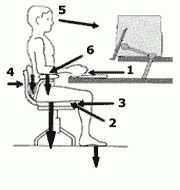Ergonomics for Prolonged Sitting
Find your care
At the UCLA Health Spine Center, our experts diagnose, manage and treat all spinal injuries and conditions. Call to connect with a spine specialist.
Back Pain When Sitting
Why does my back hurt when I sit? It’s a question anyone who works at a desk might ask themselves at some point. Sitting for prolonged periods of time can be a major cause of back pain, cause increased stress of the back, neck, arms and legs and can add a tremendous amount of pressure to the back muscles and spinal discs.
Additionally, sitting in a slouched position can overstretch the spinal ligaments and strain the spinal discs.
Besides being uncomfortable, poor sitting posture and workplace ergonomics over time can damage spinal structures and contribute to recurrent episodes of neck or back pain. Wondering how to reduce lower back and neck pain? Read on for tips.

Proper Posture for Sitting
Here are some important guidelines for how to reduce lower back and neck pain and by making sure your work area is as comfortable as possible and causes the least amount of stress to your spine to avoid pain from sitting:
- Elbow measure
Begin by sitting comfortably as close as possible to your desk so that your upper arms are parallel to your spine. Rest your hands on your work surface (e.g. desktop, computer keyboard). If your elbows are not at a 90-degree angle, move your chair either up or down. - Thigh measure
Check that you can easily slide your fingers under your thigh at the leading edge of the chair. If it is too tight, you need to prop your feet up with an adjustable footrest. If there is more than a finger width between your thigh and the chair, you need to raise the desk/work surface so that you can raise your chair. - Calf measure
With your buttocks against the chair back, try to pass your clenched fist between the back of your calf and the front of your chair. If you can't do that easily, the chair is too deep. You will need to adjust the backrest forward, insert a lumbar support or get a new chair. - Lower-back support
Your buttocks should be pressed against the back of your chair, and there should be a cushion that causes your lower back to arch slightly so that you don't slump forward as you tire. This support is essential to minimize the load (strain) on your back. Never slump or slouch in your chair, as this places extra stress on your spine and lumbar discs. - Eye level
Close your eyes while sitting comfortably with your head facing forward. Slowly open your eyes. Your gaze should be aimed at the center of your computer screen. If your computer screen is higher or lower than your gaze, you need to either raise or lower it. If you wear bifocal glasses, you should adjust the computer screen so that you do not have to tilt your neck back to read the screen, or else wear full lens glasses adjusted for near vision. - Armrest
Adjust the armrest of your chair so that it just slightly lifts your arms at the shoulders. Use of an armrest allows you to take some of the strain off your neck and shoulders, and it should make you less likely to slouch forward in your chair.
While this article is about proper posture for sitting in traditional chairs, some people prefer more active chairs, such as a Swedish kneeling chair or a Swiss exercise ball. Traditional chairs are designed to provide complete support, but a kneeling chair promotes good posture without a back support, and an exercise ball helps develop your abdominal and back muscles while you sit. It is advisable to first talk with your doctor prior to using one of these types of chairs if you have an injured back or other health problems.
Finally, no matter how comfortable you are at your desk, prolonged, static posture is not good for your back. Try to remember to stand, stretch and walk at least a minute or two every half hour. Moving about and stretching on a regular basis throughout the day will help keep your joints, ligaments, muscles, and tendons loose, which in turn will help you feel more comfortable, more relaxed, and more productive.